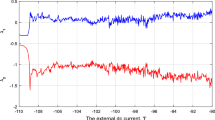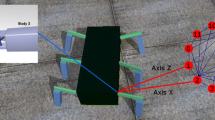Abstract
This paper studies simple three-layer digital dynamical systems related to recurrent-type neural networks. The input to hidden layers construct an elementary cellular automaton and the hidden to output layers are one-to-one connection described by a permutation. Depending on the permutation, the systems generate various periodic orbits. Applications include walking robots, switching power converters, and reservoir computing. In order to analyze the dynamics, we introduce two feature quantities that evaluate complexity and stability of the periodic orbits. Calculating the feature quantities in simple example systems, we have clarified that the systems can generate various stable periodic orbits. Presenting an FPGA based hardware prototype, typical periodic orbits are confirmed experimentally.
Access this chapter
Tax calculation will be finalised at checkout
Purchases are for personal use only
Similar content being viewed by others
References
Wolfram, S.: Cellular automata and complexity: collected papers. CRC Press (2018)
Chua, L.O.: A nonlinear dynamics perspective of Wolfram’s new kind of science. World Scientific (2006)
Schüle, M., Stoop, R.: A full computation-relevant topological dynamics classification of elementary cellular automata. Chaos 22, 043143 (2012)
Wada, M., Kuroiwa, J., Nara, S.: Completely reproducible description of digital sound data with cellular automata. Phys. Lett. A 306, 110–115 (2002)
Yilmaz, O.: Symbolic computation using cellular automata-based hyperdimensional computing. Neural Comput. 27, 2661–2692 (2015)
Tanaka, G., et al.: Recent advances in physical reservoir computing: a review. Neural Netw. 115, 100–123 (2019)
Chowdhury, D., Basu, S., Gupta, I., Chaudhuri, P.: Design of CAECC - cellular automata based error correcting code. IEEE Trans. Comput. 43, 759–764 (1994)
Hopfield, J.J.: Neural networks and physical systems with emergent collective computation abilities. Proc. Nat. Acad. Sci. 79, 2554–2558 (1982)
Michel, A.N., Farrell, J.A.: Associative memories via artificial neural networks. IEEE Control Syst. Mag. 10, 6–17 (1990)
Sato, R., Saito, T.: Stabilization of desired periodic orbits in dynamic binary neural networks. Neurocomputing 248, 19–27 (2017)
Minati, L., Frasca, M., Yoshimura, N., Koike, Y.: Versatile locomotion control of a hexapod robot using a hierarchical network of nonlinear oscillator circuits. IEEE Acess 6, 8042–8065 (2018)
Suzuki, T., Saito, T.: Synthesis of three-layer dynamic binary neural networks for control of hexapod walking robots. In: Proceedings IEEE/CNNA (2021)
Holderbaum, W.: Application of neural network to hybrid systems with binary inputs. IEEE Trans. Neural Netw. 18(4), 1254–1261 (2007)
Udagawa, H., Okano, T., Saito, T.: Permutation binary neural networks: analysis of periodic orbits and its applications. Discrete Contin. Dyn. Syst. Ser. B 28(1), 748–764 (2023)
Anzai, S., Suzuki, T., Saito, T.: Dynamic binary neural networks with time-variant parameters and switching of desired periodic orbits. Neurocomputing 457, 357–364 (2021)
Author information
Authors and Affiliations
Corresponding author
Editor information
Editors and Affiliations
Rights and permissions
Copyright information
© 2023 The Author(s), under exclusive license to Springer Nature Switzerland AG
About this paper
Cite this paper
Okano, T., Saito, T. (2023). Permutation Elementary Cellular Automata: Analysis and Application of Simple Examples. In: Tanveer, M., Agarwal, S., Ozawa, S., Ekbal, A., Jatowt, A. (eds) Neural Information Processing. ICONIP 2022. Lecture Notes in Computer Science, vol 13623. Springer, Cham. https://doi.org/10.1007/978-3-031-30105-6_27
Download citation
DOI: https://doi.org/10.1007/978-3-031-30105-6_27
Published:
Publisher Name: Springer, Cham
Print ISBN: 978-3-031-30104-9
Online ISBN: 978-3-031-30105-6
eBook Packages: Computer ScienceComputer Science (R0)




